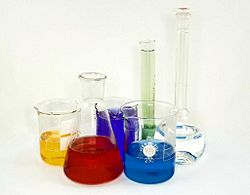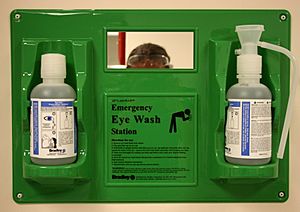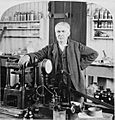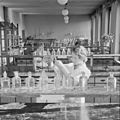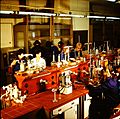Laboratory techniques facts for kids
Laboratory techniques are the special ways scientists and students use to handle tools and materials in a lab. These techniques help them do experiments safely and get accurate results. They are important for doing all kinds of science, from chemistry to biology.
Contents
Basic Lab Skills
Working with Chemicals Safely
When you need to mix things like a solid in a liquid, or two liquids together in a test tube, here are some safe ways to do it:
- Gently shake the test tube from side to side.
- Stir the mixture with a clean glass rod.
- Lightly tap the bottom of the test tube with your finger.
- Carefully pour the liquid back and forth between two test tubes.
- Put a stopper on the test tube and shake it gently.
Heating Materials in the Lab
Heating is a common step in many experiments. Here are different ways to heat materials safely:
- Hold the material over a flame, like from a Bunsen burner.
- Put the material in a water bath. This heats it gently and evenly.
- Use a "heat gun" to blow hot air at the material. This is like a powerful hairdryer for lab use.
Collecting Gases
When an experiment makes a gas, you need ways to collect it. Here are some common methods:
- Upward and downward delivery: This method uses the gas's density (how heavy it is compared to air) to collect it in a container.
- Over water: If the gas doesn't dissolve in water, you can collect it by bubbling it into an upside-down container filled with water.
- Gas syringe: This is a special syringe that can draw in or push out gases, allowing for precise measurement.
Drying Substances
Sometimes, you need to remove water from a substance. Here are two ways to dry materials:
- Evaporation at room temperature: You can leave the mixture out in the open. The water will slowly turn into vapor and disappear.
- Using an oven: For faster drying, you can put the substance in a special lab oven. This oven heats it gently and helps the water vapor escape.
How to Safely Smell Gases
It's very important to be careful when smelling gases in a lab. Some gases can be harmful.
- Never put your nose directly over a container to smell a gas.
- If you need to smell a gas and it's known to be safe, gently waft some of the gas towards your nose with your hand.
- Never try to smell a gas that is known to be toxic or dangerous. Always ask your teacher or a supervisor if you are unsure.
Images for kids
-
A medical laboratory run by the Graduate Institute of Cancer Biology of China Medical University (Taiwan)
-
The Schuster Laboratory, University of Manchester (a physics laboratory)
-
Chemistry laboratory of the 18th century, of the sort used by Antoine Lavoisier and his contemporaries
-
Thomas Edison in his laboratory, 1901
-
Early 2000s style of counter in Chemical Laboratory, Mahidol University International College, Thailand
-
Laboratory for organic Chemistry at the University of Applied Science Aachen, Campus Jülich, Germany
See also
 In Spanish: Laboratorio para niños
In Spanish: Laboratorio para niños



